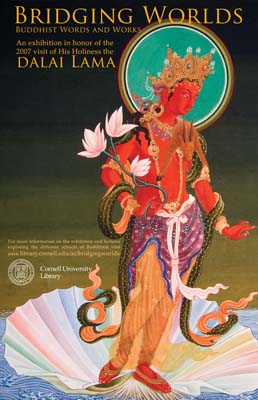Cornell University Library celebrated the historic visit of the Dalai Lama to Ithaca, New York in October 2007 with Bridging Worlds: Buddhist Words and Works, an exhibition and lecture series. While events across campus and throughout the community focused on Tibetan religion and culture, the Library’s program looked to the larger context, sweeping across Buddhist Asia, from northeastern India to the Himalayas, Indonesia, and Japan, and many points in between.
Buddhism, in one form or another, is a truly pan-Asian culture trait. For over 2000 years now buddhadharma has tied the vast continent’s disparate regions together in networks of trade, teaching, and pilgrimage. At the same time, each region of Asia has developed its own signature forms of Buddhist thought and practice. In and out of alliance with political power, arguing abstruse and difficult philosophies, building monuments and metaphors, Buddhists of South, Southeast and East Asia have made and remade their respective worlds. Cornell’s Kroch Asia Library is full of their words and works—we offer just a sample here.
Just how Asia’s various forms of Buddhism relate to one another is a difficult question. In part, their relationship is developmental. The Theravada (School of the Elders) claims to be the oldest tradition. It focuses on progress towards Enlightenment through the course of many lives. The Mahayana (Great Way) builds on Theravada teachings, but broadens its scope to aim at Enlightenment for all sentient beings as the highest good. The Vajrayana (Adamantine Way) adds to Theravada and Mahayana the knowledges and practices of tantra, aimed at speedy and efficacious transcendence through unorthodox means. Texts, deities, and practices of the three schools co-exist and commingle in most regions of Asia, and the situation is further complicated by the presence of other religions and belief systems in each locale. For present purposes it is perhaps enough to know that the Theravada is now predominant in Southeast Asia, Mahayana is characteristic in East Asia, and Vajrayana distinguishes the Himalayan region of South Asia.
The figure below maps the spread of Buddhism from the 4th century BC to the 6th century A.D. onto the three regions of modern Asia as construed in Cornell’s collections.

Courtesy of the Map Collection, Cornell University Library, with special thanks to Nij Tontisirin.
This exhibition is co-sponsored by the following Cornell University Programs:
– East Asia Program
– South Asia Program
– Southeast Asia Program
